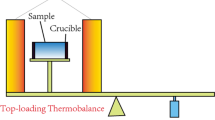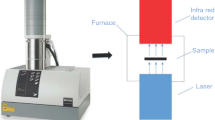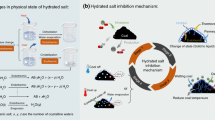Abstract
This tissue developed the new environmental protection chemical composite inhibitor (CCI) for the effective inhibition of coal spontaneous combustion. CCI is combined by using sodium dodecyl sulfate, sodium laurylsulfonate, flame-retardant compound, xanthan gum and deionized water, and all the materials blend solutions with 1%, 5%, 10% and 20% concentrations. Coal samples treated with blended solutions with 1%, 5%, 10% and 20% concentrations are tested separately on the temperature-programmed oxidation test platform for loading coal samples in order to research the effectiveness and properties of solutions inhibiting oxidized spontaneous combustion of coal, which investigates and analyzes impacts on the parameters of coal spontaneous combustion, and then comparing to those of the untreated and water-treated coal samples. Experimental results showed that the developed inhibitor had remarkable inhibition effects on the CO generation and oxygen consumption rate for the treated coal samples. The individual and averaged inhibitor rates both increase with the increase in inhibitor solution concentration, and for 20% inhibitor-treated samples, these rates reached 85.92% and 67.26%, respectively. The statistical regression analysis showed that the inhibitor concentration and the averaged inhibition rate exhibited a strong logarithmic function relationship. In addition, the spontaneous combustion inhibition mechanism was discussed from both the macro- and micro-perspectives.









Similar content being viewed by others
References
Kong B, Li ZH, Yang YL, Liu Z, Yan DC. A review on the mechanism, risk evaluation, and prevention of coal spontaneous combustion in China. Environ Sci Pollut Res. 2017;24(30):23453–70.
Yang Y, Tsai YT. Inhibition ability of ionic liquid [Bmim][NO3], [Bmim][BF4], and [Emim][BF4] on spontaneous coal combustion. J Therm Anal Calorim. 2018;132(3):1943–51.
Zhang LL, Shi BM, Qin BT, Wu Q, Dao VC. Characteristics of foamed gel for coal spontaneous combustion prevention and control. Combust Sci Technol. 2017;189(6):980–90.
Qin BT, Lu Y, Li Y, Wang DM. Aqueous three-phase foam supported by fly ash for coal spontaneous combustion prevention and control. Adv Powder Technol. 2014;25(5):1527–33.
Lu XX, Wang DM, Qin BT, Tian FC, Shi GY, Dong SJ. Novel approach for extinguishing large-scale coal fires using gas-liquid foams in open pit mines. Environ Sci Pollut Res. 2015;22(23):18363–71.
Yang YL, Li ZH, Si LL, Hou SS, Zhou YB, Qi QQ. Consolidation grouting technology for fire prevention in mined-out areas of working face with large inclined angle and its application. Fire Mater. 2016;41(6):700–15.
Cui CB, Jiang SG, Zhang WQ. Experimental study on the effect of thermo-responsive secundine inhibitor on coal spontaneous combustion. Energy Fuels. 2017;31(12):14262–9.
Ma LY, Wang DM, Wang Y, Xin HH, Dou GL, Xu CH. Experimental investigation on a sustained release type of inhibitor for retarding the spontaneous combustion of coal. Energy Fuels. 2016;30(11):8904–14.
Pan RK, Zheng LG, Yu MG, Lu C. Research of new material restraining coal spontaneous combustion by the way of release water mist. Adv Mater Res. 2012;548:807–11.
Slovák V, Taraba B. Urea and CaCl2 as inhibitors of coal low-temperature oxidation. J Therm Anal Calorim. 2012;110(1):363–7.
Colaizzi GJ. Prevention, control and/or extinguishment of coal seam fires using cellular grout. Int J Coal Geol. 2004;59(1–2):75–81.
Wang G, Yan GQ, Zhang XH, Du WZ, Huang QM, Sun LL, et al. Research and development of foamed gel for controlling the spontaneous combustion of coal in coal mine. J Loss Prevent Proc. 2016;44:74–486.
Qin BT, Ma D, Li FL, Li Y. Aqueous clay suspensions stabilized by alginate fluid gels for coal spontaneous combustion prevention and control. Environ Sci Pollut Res. 2017;24(31):24657–65.
Taraba B, Peter R, Slovák V. Calorimetric investigation of chemical additives affecting oxidation of coal at low temperatures. Fuel Process Technol. 2011;92(3):712–5.
Pandey J, Mohalik NK, Mishra RK, Khalkho A, Kumar D, Singh VK. Investigation of the role of fire retardants in preventing spontaneous heating of coal and controlling coal mine fires. Fire Technol. 2015;51(2):227–45.
Pan RK, Chen L, Yu MG, Xiao ZJ, Fu D, Chen JJ. Oxidation characteristics of unloaded coal under different initial stress. J China Coal Soc. 2017;42(9):2369–75.
Qin BT, Lu Y. Experimental research on inorganic solidified foam for sealing air leakage in coal mines. Int J Min Sci Technol. 2013;23(1):151–5.
Lu Y. Laboratory study on the rising temperature of spontaneous combustion in coal stockpiles and a paste foam suppression technique. Energy Fuels. 2017;31(7):7290–8.
Deng J, Zhao JY, Zhang YN, Wang CP. Micro-characteristics of spontaneous combustion of second oxidation with different rank coals. J China Coal Soc. 2016;41(5):1164–72.
Tang YB, Xue S. Influence of long-term water immersion on spontaneous combustion characteristics of Bulianta bituminous coal. Int J Oil Gas Coal Technol. 2017;14(4):398–411.
Deng J, Bai ZJ, Xiao Y, Shu CM. Effects on the activities of coal microstructure and oxidation treated by imidazolium-based ionic liquids. J Therm Anal Calorim. 2018;133(1):453–63.
Zhu JF, He N, Li DJ. The relationship between oxygen consumption rate and temperature during coal spontaneous combustion. Saf Sci. 2012;50(4):842–5.
Qi XY, Li QZ, Zhang HJ, Xin HH. Thermodynamic characteristics of coal reaction under low oxygen concentration conditions. J Energy Inst. 2017;90(4):544–55.
Pan RK, Fu D, Chen L, Xiao ZJ, Jia HL. Study on oxidation characteristics of unloaded coal under different air leakage condition. Coal Sci Technol. 2018;46(1):133–8.
Cui CB, Jiang SG, Shao H, Zhang WQ, Wang K, Wu ZY. Experimental study on thermo-responsive inhibitors inhibiting coal spontaneous combustion. Fuel Process Technol. 2018;175:113–22.
Ni GH, Li Z, Xie HC. The mechanism and relief method of the coal seam water blocking effect (WBE) based on the surfactants. Powder Technol. 2018;323(1):60–8.
Yang Y, Tsai YT, Zhang YN, Shu CM, Deng J. Inhibition of spontaneous combustion for different metamorphic degrees of coal using Zn/Mg/Al–CO3 layered double hydroxides. Process Saf Environ. 2018;113:401–12.
Li JH, Li ZH, Yang YL, Kong B, Wang CJ. Laboratory study on the inhibitory effect of free radical scavenger on coal spontaneous combustion. Fuel Process Technol. 2018;171:350–60.
Wang Y, Cheng YS, Yu MG, Li Y, Cao JL, Zheng LG, et al. Methane explosion suppression characteristics based on the NaHCO3/red-mud composite powders with core-shell structure. J Hazard Mater. 2017;335:84–91.
Li ZH, Kong B, Wei AZ, Yang YL, Zhou YB, Zhang LZ. Free radical reaction characteristics of coal low-temperature oxidation and its inhibition method. Environ Sci Pollut Res. 2016;23(23):23593–605.
Tang YB, Li ZH, Yang YL, Ma DJ, Ji HJ. Effect of inorganic chloride on spontaneous combustion of coal. J S Afr Inst Min Metall. 2015;115(2):87–92.
Zheng LG, Li G, Wang YL, Zhu XC, Pan RK, Wang Y. Effect of blockage ratios on the characteristics of methane/air explosion suppressed by BC powder. J Hazard Mater. 2018;353:25–33.
Acknowledgements
This work was carried out with funding from the National Key R&D Program of China (2018YFC0808100), National Natural Science Foundation of China (Grant Nos. 51304070, 51674103) and supported by the Science Research Funds for the Universities of Henan Province. The authors wish to thank these organizations for their support. They also wish to thank the readers and editors for their constructive comments and suggestions to improve the manuscript.
Author information
Authors and Affiliations
Corresponding author
Additional information
Publisher's Note
Springer Nature remains neutral with regard to jurisdictional claims in published maps and institutional affiliations.
Rights and permissions
About this article
Cite this article
Pan, R., Ma, J., Fu, D. et al. Experimental study on the new environmental protection chemical composite inhibitor for the inhibition of coal spontaneous combustion. J Therm Anal Calorim 139, 37–45 (2020). https://doi.org/10.1007/s10973-019-08427-x
Received:
Accepted:
Published:
Issue Date:
DOI: https://doi.org/10.1007/s10973-019-08427-x




